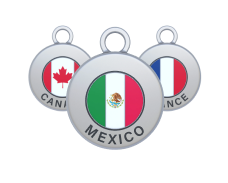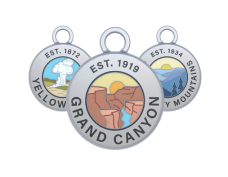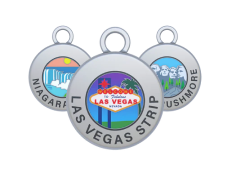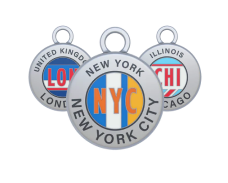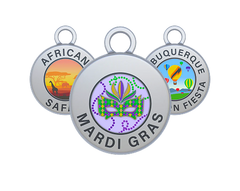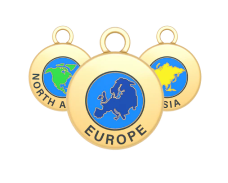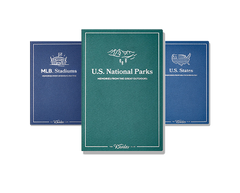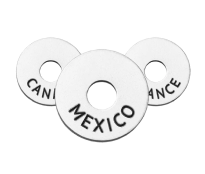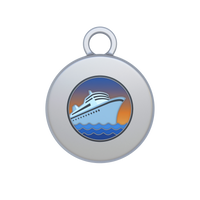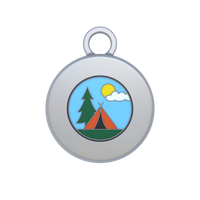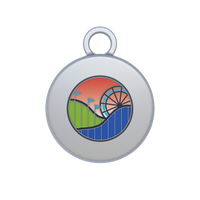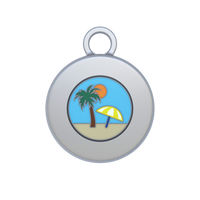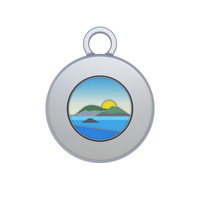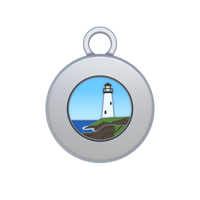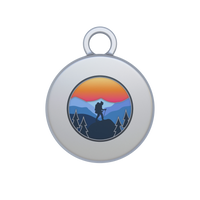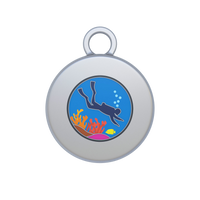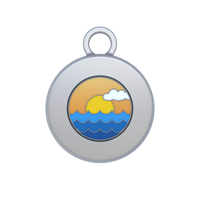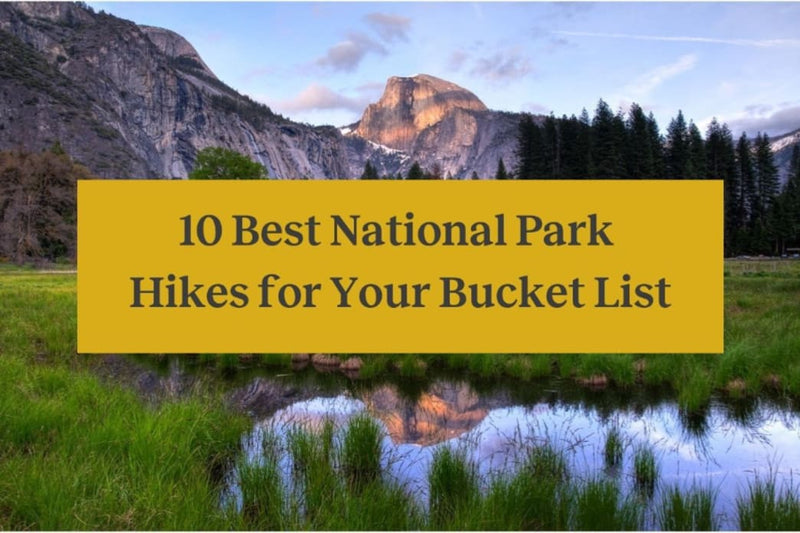
Hiking is unquestionably one of the best ways to explore our national parks — though, we’d like to point out, far from the only way.
But with thousands of equally epic options, how do you decide which are the best national park hikes? Good news: we’ve done the very literal legwork and put together 10 of the best national park hiking trails.
Note that while many people do some of the longer trails as overnight backpacking trips, they can all be completed as single-day hikes.
Best National Park Hikes
From an active volcano to a glacier and everything in between, our list of the best national park hikes has something for everyone!
1. Delicate Arch, Arches
Distance: 3.2 miles
Difficulty: Moderate
This relatively short (but not exactly sweet) trail gets you up close and personal with Delicate Arch, which the National Park Service calls “one of the most famous geologic features in the world.”
The trailhead starts near the historic Wolfe Ranch cabin, then passes ancient Ute Indian petroglyphs before ramping up — literally.
Once you reach the sandstone section, you’ll be marching straight up. It’s not particularly steep, but it is a steady climb that leaves even experienced hikers huffing and puffing.
Try to time your arrival to the massive stone arch for either sunrise or sunset. It will be crowded either way, but worth it.
2. Cadillac Mountain, Acadia
Distance: 4.4 miles
Difficulty: Moderate
All the trails on our list can be considered the best national park hikes, but Cadillac Mountain has something no others do: the first sunrise in the U.S. (from early October through early March, that is).
Even if you sleep in, Cadillac Mountain’s 360-degree views are well worth the hike. You’ll see numerous bays, lakes, and mountain ranges, plus Maine’s iconic rocky coastline.
We recommend the popular North Ridge Trail, which is one of three options for reaching the summit. The others are the extremely steep 3.1-mile West Face Trail and South Ridge Trail, which is 7 miles and one of the longest trails in the park.
3. Angels Landing, Zion
Distance: 5.4 miles
Difficulty: Strenuous
Calling all thrillseekers! If you’re up for challenging your physical and mental capabilities, Angels Landing should be at the top of your bucket list.
Fairly quickly, you’ll start up a set of steep switchbacks. This hike is rated strenuous for a reason. Hikers find a brief respite in the perpetually-cool Refrigerator Canyon, then face Walter’s Wiggles, another set of steep(er) switchbacks.
At the top of Walter’s Wiggles, you’ll be on Scout’s Landing. Here, you get an excellent view of Angels Landing’s iconic spine — and have the opportunity to decide whether you’ll continue up or not.
Finally, brave hikers (and those with no fear of heights) will take on the infamous “chains section.”
You’ll hike and climb about 500 feet of narrow and completely exposed rock. It can be intimidating, but it’s totally manageable if you take your time, use the chains, and be respectful of other hikers.
4. Darwin Falls, Death Valley
Distance: 2 miles
Difficulty: Easy
Most people know about Death Valley’s salt flats, vast sand dunes, badlands, and extreme temperatures. But most people haven’t heard of Darwin Falls...as in, waterfalls. In Death Valley.
Darwin Falls defies all odds in this harsh environment and somehow flows year-round, which makes it one of the best national park hikes (and certainly one of the most unexpected!).
The trail starts in a drab gravel wash. At just 0.6 miles in, however, you’ll cross a creek and enter a lush canyon. Another 0.3 miles, and you’ll come to the falls. The lower falls are about 25 feet tall. If you can find a path to safely scramble a few large rock walls, you’ll see the entire 140-foot-tall, three-tiered waterfall.
Because it’s located in Death Valley’s more remote west side and off on its own, Darwin Falls is largely unknown. Don’t be surprised if you’re the only one on the trail!
5. Iceberg Lake, Glacier
Distance: 9.7 miles
Difficulty: Strenuous
In a national park known for jaw-droppingly beautiful hiking trails, Iceberg Lake in East Glacier is exceptional.
As its name implies, the lake has large chunks of ice floating in it most of the year — if that doesn’t qualify as one of the best national park hikes, we don’t know what does!
You’ll be on the Ptarmigan Trail for some of this hike, and the elevation gain is moderate. 4.5 miles from the trailhead, you’ll walk through a field of brilliant wildflowers and get your first glimpse of Iceberg Lake. It’s surrounded by towering mountains, blocking almost all sunlight and preventing the icebergs from melting.
Although it tends to be crowded, it’s easy to find a spot of lakeshore all to yourself the further you get from the trail.
6. Hoh River Trail, Olympic
Distance: up to 17.3 miles
Difficulty: Moderate
Olympic National Park’s Hoh River Trail is stunningly beautiful and unique in many ways. For starters, it’s inside the Hoh Rainforest, one of just a literal few temperate rainforests in America. That alone makes it one of the best national park hikes!
Another way the Hoh River Trail is unique is that some of the best scenery is at the beginning. The trail extends 17.3 miles to Blue Glacier, but many people only hike a portion of that.
The most scenic stretch of the trail is the 5.3 miles to Five Mile Island. You’ll marvel at iconic PNW scenery: moss dripping from huge, ancient trees, gently bubbling creeks, mountains peeking out from clouds in the distance.
At Five Mile Island, which is actually a sandbar in the river, keep your eyes open for elk and deer. This is a great place to picnic, swim, and turn around the way you came.
7. Notch Trail, Badlands
Distance: 1.5 miles
Difficulty: Easy
This is one of the best national park hikes because of how much diverse terrain you get to see in such a short distance.
Hikers start on a wide-open, flat trail, in an area where several other trailheads also begin. Soon, you’re in a canyon, hiking among the badland formations.
Arguably the best part of this hike is the 50-foot wooden ladder that takes you back up the canyon wall. At the top, the trail narrows and follows the rock edge. There are some sheer dropoffs here, but the path is wide enough that you shouldn’t have any problems.
The trail soon opens up and you’re treated to expansive views of the badlands. Insider tip: you’re facing west here, so this is a great spot to watch the sunset!
8. Half Dome, Yosemite
Distance: 14-17 miles
Difficulty: Extremely strenuous
Yosemite’s Half Dome is easily one of the best national park hikes in the entire world. Only the most experienced hikers should attempt it, though, because it’s long, grueling, and extremely technical.
Depending on your exact route (you can take the Mist Trail one way and the JMT the other, or stick with just one), you’ll hike a total of 14-17 miles.
Every single one of those miles is challenging. Yes, even the first one. Actually, especially the first one!
The trail to Half Dome will take you by waterfalls and through dense Sequoias, then ultimately up the famed Cables Route to the summit.
Note that you need a permit to hike the Half Dome Cables Route from May through October, when the cables are up.
9. Kalapana Lava Viewing Hike, Hawaii Volcanoes
Distance: 9-11 miles roundtrip
Difficulty: Moderate
There aren’t many places you can hike across active lava flow, but we have one of them right here in the U.S!
On the Kalapana Lava Viewing Hike at the Big Island’s Kīlauea volcano, not only do you walk across active lava flow, but you can also witness molten lava flowing directly into the ocean!
Unlike many of the best national park hikes, this one doesn’t include sweeping mountain vistas or alpine lakes. Instead, hikers trek across a barren lava flow field to a viewpoint overlooking the Pacific Ocean, where molten lava slowly seeps in.
If at all possible, plan this hike for sunset or later. The evening light lets you see the lava glowing with smoke coming off of it, and it’s truly surreal watching it fall into the ocean!
Before heading out, check the park’s ‘What’s Going on With the Volcanoes?’ page for up-to-date information on current lava flow conditions.
10. Exit Glacier, Kenai Fjords
Distance: 2.2 miles
Difficulty: Easy to moderate
Much like hiking over active lava flow, how often can you say you hiked across a real glacier? Luckily, Kenai Fjords’ Exit Glacier is one of the most accessible in all of Alaska!
The Exit Glacier trail is partially paved and is actually several short, flat loop paths connected to various overlooks.
Along the trail, pay close attention to the signage. NPS places signs annually, marking the “toe” of the glacier to indicate how much it receded in the previous year.
Seeing the glacier up close is fascinating, of course, but the firsthand example of climate change is something unique you’ll only find at an Alaska national park.
With so many great national park hikes to choose from, the hardest decision is where to start! Lace up your hiking boots, pack plenty of layers, and always remember to practice Leave No Trace principles.
Most of all, have fun! And speaking of fun, don’t forget some memorable souvenirs of your hiking adventures.
U.S. National Park Tokens from The Wander Club are a wonderful and stylish way to show off where you’ve been — plus they make great conversation starters! Happy shopping...and hiking!

